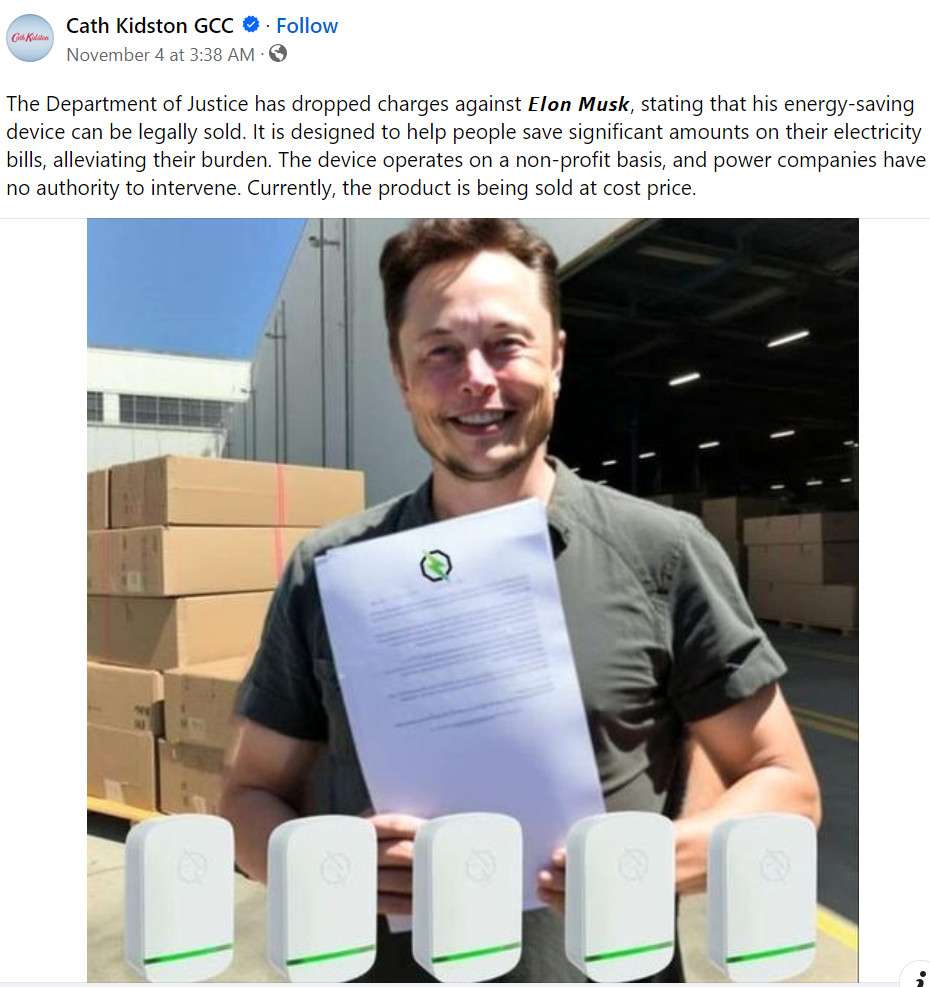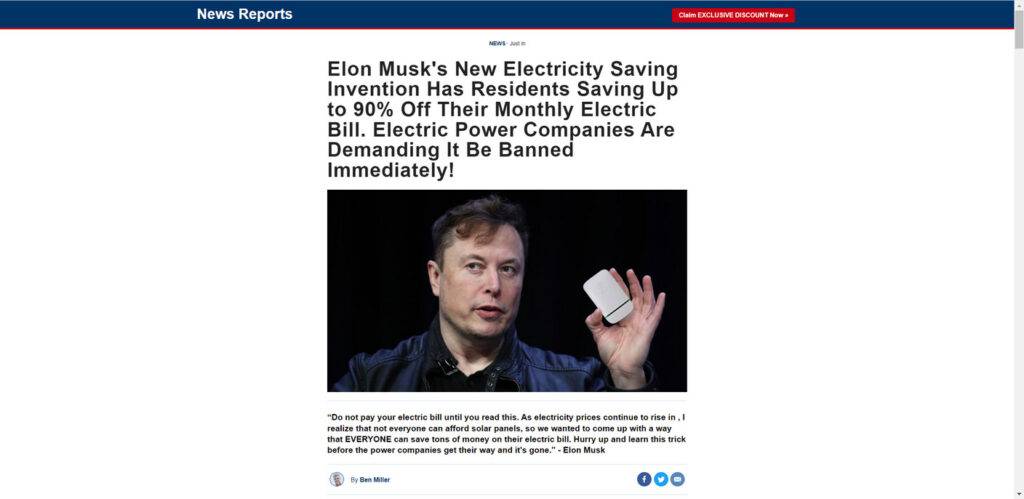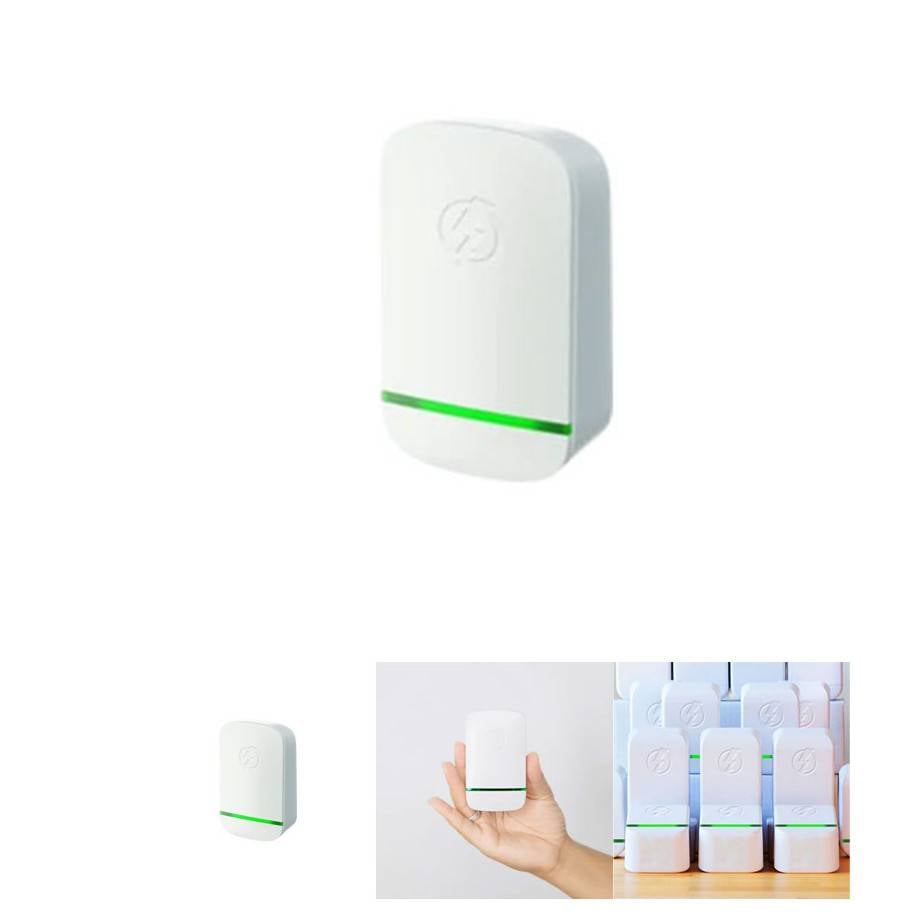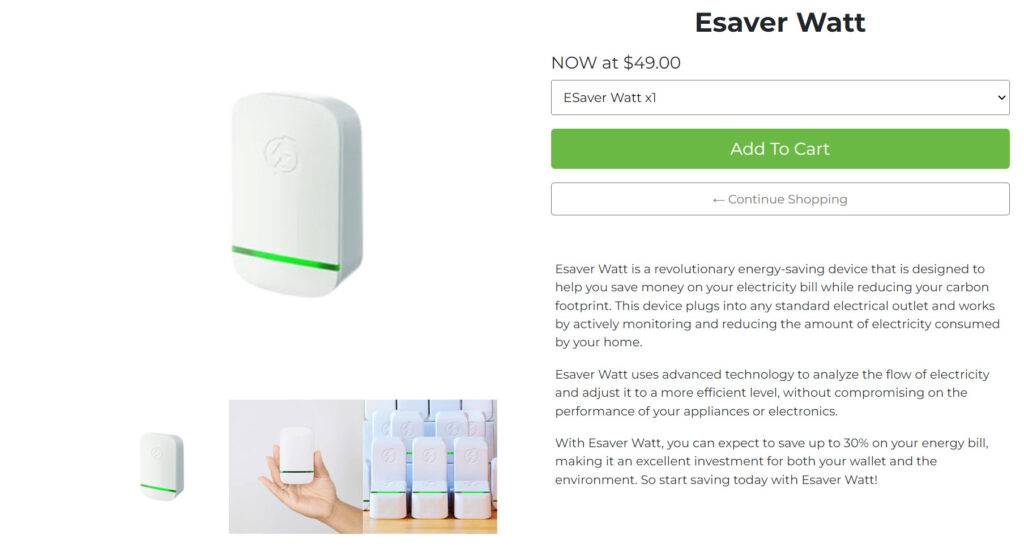Elon Musk’s name and reputation have been used by scammers to promote and sell dubious “energy-saving” devices that do not work as advertised. These products go by names like Stop Watt, Miracle Watt, True Watt, Real Watt, Watt Rescue, Esaver Watt, Pro Power Save, Voltmod and more. They falsely claim to be endorsed by Musk and reduce your electricity bills.
This article provides an overview of how this scam works, advice for victims, and answers common questions.




This Article Contains:
Overview of the Scam
For several years, fraudsters have been running an elaborate scam exploiting Elon Musk’s name and reputation to cheat thousands of innocent consumers. This guide will provide an in-depth overview of how the “Elon Musk Energy Saver Scam” operates at every stage to help potential victims identify and avoid it.
The operators create sophisticated fake advertisements depicting Musk endorsing dubious electricity saving gadgets with names like “Stop Watt”, “Watt Rescue”, “Power Saver”, and more. Using doctored images and fabricated quotes, they falsely claim Musk invested in the products or assisted their development, lending his tech genius credibility to convince victims.
Slick websites reinforce the deception using pseudo-scientific terminology, bogus certification badges, fake 5-star reviews, and even completely fabricated stories of Musk battling power companies in court to sell the devices. This helps establish legitimacy and urgency around purchasing the products.
In reality, there exists no evidence indicating Musk ever endorsed these specific products in any capacity. The scammers exploit his name, quotes, and likeness without consent solely to deceive consumers. Their only motive is personal enrichment through stealing payments.
Once purchases are made, the fraudsters pocket the money while victims receive cheap plastic LED lights or surge protectors with no meaningful energy saving functionality, if anything arrives at all. Requests for refunds are invariably ignored as the shifty operators shut down websites and vanish.
Authorities have limited recourse combatting these “empty box” scams with no paperwork trail. Preventing consumers falling prey remains the priority.
Hallmarks of the Energy Saver Scam
Several consistent markers characterize the Elon Musk Energy Saving Device Scam making it identifiable:
- Too-good-to-be-true claims of dramatic electricity bill reductions through vague “power stabilization” or “dirty electricity filtering” pseudoscience. Outlandish promises should raise suspicions.
- Fake endorsements and investments attributed to Elon Musk lending undeserved credibility to otherwise unverified products. Musk only backs products he personally announces.
- Pressuring sales tactics pushing discounted offers with short time windows before prices rise exponentially. This manufactures false urgency to purchase worthless products.
- Lack of legitimate documentation like certified testing reports confirming functionality. Dubious badges mimic certifications.
- Recent domain registration dates, temporary email addresses, and other website anonymity indicators evidencing short-lived scam sites.
- Complete absence of realistic refund/return policies or customer service contact options.
With awareness of these red flags, consumers can more readily identify and avoid the Energy Saver Scam no matter where its deceptive advertisements appear across social media, search engines, or email spam campaigns. Preventing payment upfront remains key to avoiding losses from this prolific racket exploiting Musk’s reputation.
How the Elon Musk Energy Saving Device Scam Works
Here is a step-by-step look at how this predatory scam operates to manipulate and deceive consumers:
1. Fake Ad Campaigns
The scammers run ads on social media, popups, emails and search engines touting revolutionary devices that can slash electricity bills. The ads claim to be selling the latest technology backed by Elon Musk.
Common tactics include fake customer testimonials, time-limited discounts and exaggerated claims of saving 50% or more on your power bills. This drums up interest in the scam product.
2. Convincing Sales Pages
The ads lead to sophisticated sales websites that reinforce the impression of a legitimate product with fake logos, celebrity endorsements, doctored before-and-after photos and other tricks.
They make pseudo-scientific claims these devices “stabilize” electrical currents, “rebalance” loads or employ other techno-babble. The sites include fake limited time discounts and may show insanely high “regular” prices crossed out to make the price seem like a steal.
3. No Real Contact Information
Scrutinize the site and you will find no company address, no contact number, no business registration details – just an online order form. This lack of a paper trail should raise red flags.
4. Upfront Payment, No Questions Asked
Unlike a real business, the sites take full payment upfront via credit card or PayPal with no questions or vetting. Real businesses take payment only upon shipping a verified product. The scammers don’t care if you receive anything usable or not – they get paid either way.
5. Shipment of Fake Products
Weeks later, customers may receive a cheap plastic device that does nothing to reduce electricity usage. Or sometimes no product arrives at all.
These devices actually waste more power than they save. The scammers profit handsomely either way.
6. Shut Down and Repeat
When people start catching on, the scammers take down the site and pop up under a new company name, with the same fake product. They keep running the scam this way to evade law enforcement and pocket millions.
This bait-and-switch operation means consumers have no way to contact the “company” later for refunds or complaints. You will find no phone support – just a non-functional email that bounces back.
Recognizing Fake Energy Saving Devices
Here are red flags to recognize one of these scammer products:
- Outlandish claims of 50-90% energy savings with no credible proof. Genuine energy savers provide more modest savings of 5-20%.
- Claims to “stabilize” current, “rebalance loads” and other technobabble. These mean nothing.
- Heavy use of Elon Musk’s name, quotes and image indicating his endorsement. Musk has never endorsed any such products.
- No real contact information, company details, address or phone number – just an online order form.
- Requirement to pay the full amount upfront before receiving the product. Real firms charge upon shipment.
- High regular prices crossed out to make the price look heavily discounted. This is purely for show.
- Fake endorsements using celebrity names and media logos without permission.
- No money-back guarantee or warranty of any kind in the small print.
- No customer reviews anywhere from verified buyers – only fake positive testimonials.
- Delayed or no shipment, ignoring refund requests. The “company” shuts down after collecting payments.
You are looking at a scam if you see these signs. No genuine energy-saving device will display them.
What’s Really Inside the Energy Saving Devices?
Since these so-called “Elon Musk Energy Saving Devices” fail to actually reduce electricity usage, what do they really contain inside?
Independent technology analysis and unboxing videos have revealed the devices harbor only cheap, basic components with no legitimate energy-saving capabilities:
- A simple circuit board
- Low-grade capacitor
- LED indicator light
- Standard electrical plug
In essence – commodity parts that provide zero energy conservation function while deceiving buyers.
The onboard capacitor may supply minor power factor correction, but this does not lower total energy draw. The LED light is merely an illusion the device is actively “working” when plugged in.
Across the board, electrical engineering experts have debunked the outlandish efficiency claims. These gadgets cannot actively “stabilize” voltage, curb waste from other electronics, or deliver meaningful surge protection as advertised.
Ultimately, the Energy Saving Devices contain nothing beyond basic electronics enclosed in plastic housing. They are functionally empty scam gadgets without any ability to reduce energy bills. The LED light and capacitor serve to disguise the worthless nature of the devices while demanding premium prices.
By better understanding the useless internal components, potential victims can avoid being deceived by the Energy Saver Scam’s hollow promises and fake functionality. Claims of dramatic electricity savings require advanced circuitry – none of which appears inside these fraudulent devices.
Dangers of the Energy Saving Devices Scam
Besides simply wasting money on an ineffective device, there are more serious risks associated with products:
- Fire hazard – Electrical devices that are poorly made in other countries can overheat and ignite fires.
- Damages appliances – Faulty electrical devices can actually damage or fry your expensive appliances and electronics.
- Data theft – Deceptive sites like the one promoting these Energy Saving Devices can steal your credit card and personal information for identity theft.
- Delay real savings – Buying bogus products prevents you from taking legit steps to reduce energy usage and bills.
These Energy Saving Devices can potentially put your home and financial information at risk. It also causes consumers to waste time and money on fake electrical savings rather than proven solutions.
What to Do If You Are a Victim of This Scam
If you paid for one of these fake products advertised using Elon Musk’s name and face, here are important steps to take:
- Call your bank immediately: Report fraudulent charges if you paid by credit card. Request an urgent chargeback explaining it is a scam. Provide the ads and webpage screenshots as proof. This is the fastest way to try recovering your money.
- Dispute the charges with PayPal: If you paid through PayPal, report unauthorized charges. Submit proof of the scam and ask for a refund under PayPal’s Buyer Protection Policy.
- Report online fraud: File complaints with the FBI Internet Crime Complaint Center at www.ic3.gov and the FTC at www.ftccomplaintassistant.gov. Include all details to aid law enforcement. Also notify cybercrime authorities in your state.
- Leave negative reviews: Post detailed scam warnings on consumer complaint sites like Ripoff Report and ScamAdvisor to alert others. Name the website, company and product. The more awareness about such scams, the fewer victims.
- Warn your followers: Expose the scam on social media channels if you promoted or believed it earlier. Make your followers aware so they don’t fall for it.
- Reverse Google search: Do a reverse image search using the celebrities’ photos on the site to find the original source and prove they are fake. Report DMCA violations.
- Demand a refund: Send a registered legal notice to the contact addresses and emails demanding an immediate and full refund. This adds pressure, but likely will not recover your money since these are fake companies.
- Be more careful next time: Learn from this experience how to spot scams. Do not believe claims that seem too good to be true. Always research advertised products extensively before buying, especially online. Only buy from real companies you can easily verify.
Frequently Asked Questions
Here are answers to common questions about the Elon Musk energy saving device scam:
Are these energy saving devices endorsed by Elon Musk?
No. Elon Musk has not endorsed any energy saving device called Stop Watt, Miracle Watt, True Watt, etc. The scammers falsely claim his backing.
How do you recognize these scams?
Warning signs include exaggerated claims, fake celebrity endorsements, no company details, upfront payment requirement and no way to contact them later. Genuine products will not have these red flags.
Can these devices really cut your electricity bill?
No. The devices sent are cheap plastic with LED lights or basic surge protectors that cannot significantly reduce your energy usage. The few that do arrive are not worth the price paid.
Are the endorsements from celebrities and media real?
No. The scammers fake endorsements using celebrity names and show logos like ABC Shark Tank without permission. Image reverse searches prove the photos are edited.
Are the customer reviews real or fake?
The “reviews” are completely fabricated. There will be no reviews from real, verified buyers, only generic 5-star reviews posted to fake credibility.
What if no device arrives after payment?
This commonly happens. Contact your bank or payment provider immediately and report fraudulent charges. File detailed complaints with the FTC, IC3, BBB and cybercrime authorities to aid investigations.
How else can you get your money back?
If you paid by credit card, request an urgent chargeback for services not provided. PayPal buyers can file disputes within 180 days under Purchase Protection. Leave negative reviews warning others of the scam.
Can you track down these scammers?
Unfortunately, not easily. They provide no real contact info and shut down quickly after collecting payments, only to open under new names which makes them hard to catch. Law enforcement needs many detailed scam reports to help locate them.
How can you avoid such scams?
Stick to established, reputable brands and stores. Research unfamiliar products extensively before purchasing, especially if they claim celebrity backing or miraculous results. Never pay any company upfront without vetting them first. Scrutinize the site for real contact details. Be very skeptical of online miracle cures or money-saving solutions promising unbelievable results.
The Bottom Line
In summary, beware of any products named Stop Watt, Miracle Watt, Watt Rescue etc. using Elon Musk’s name and image under the pretense of saving electricity costs. They are not endorsed by Musk.
These scammers have swindled people out of millions over the years using fake celebrity endorsements, press quotes, doctored images and other deceptive sales tactics. Their products do not work as advertised. They pocket payments upfront and shut down before shipping anything.
Always thoroughly research unfamiliar companies and analyze extraordinary claims before buying. If you unfortunately already paid these scammers, initiate chargebacks and refunds immediately and report them to the relevant authorities. Learn to recognize the warning signs of similar scams, so you don’t fall victim again. Be extra vigilant when shopping online.










